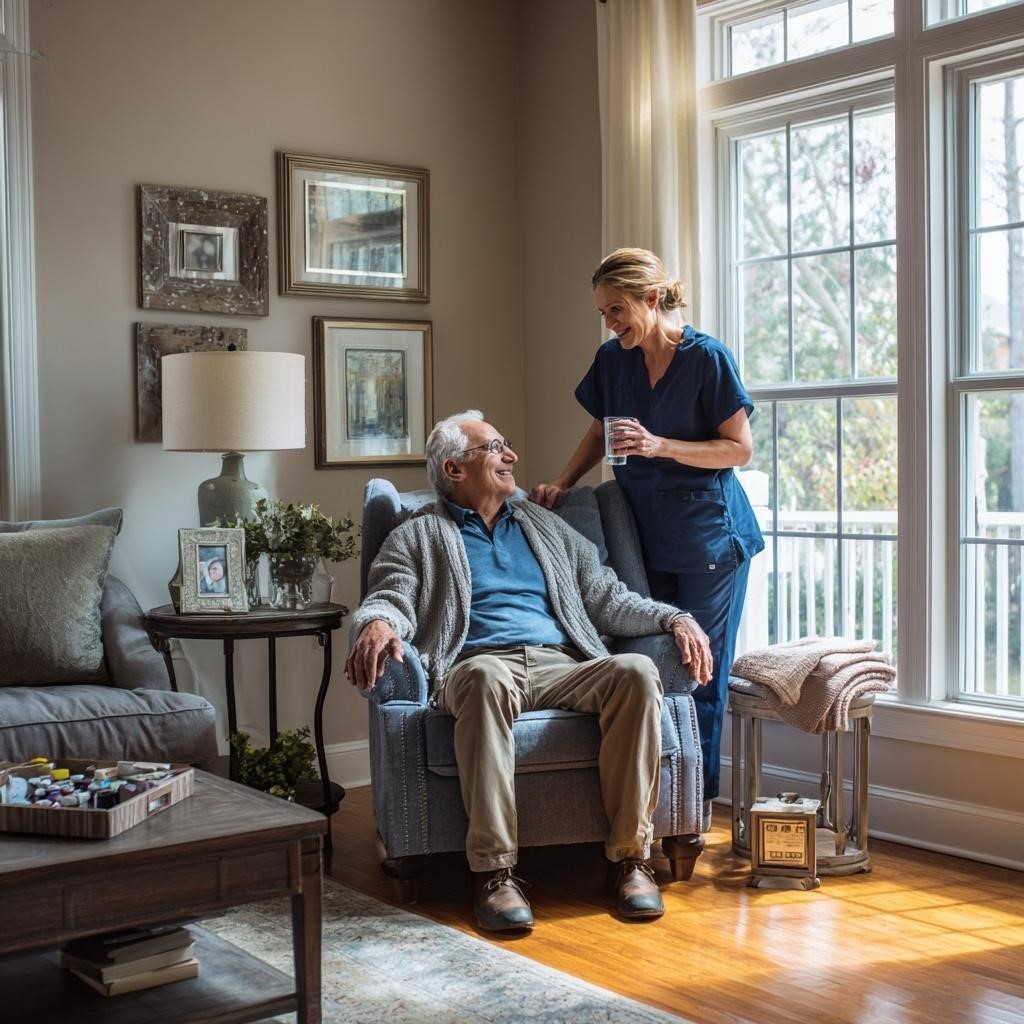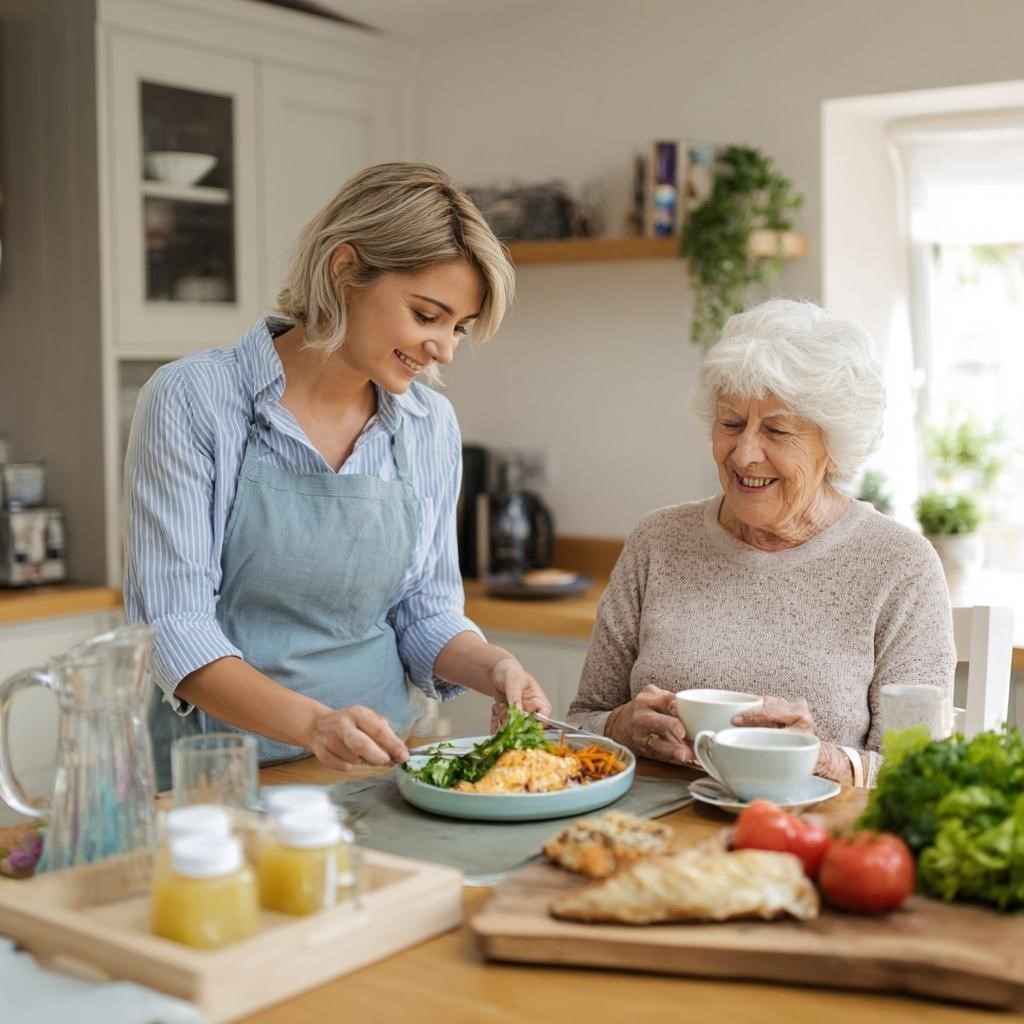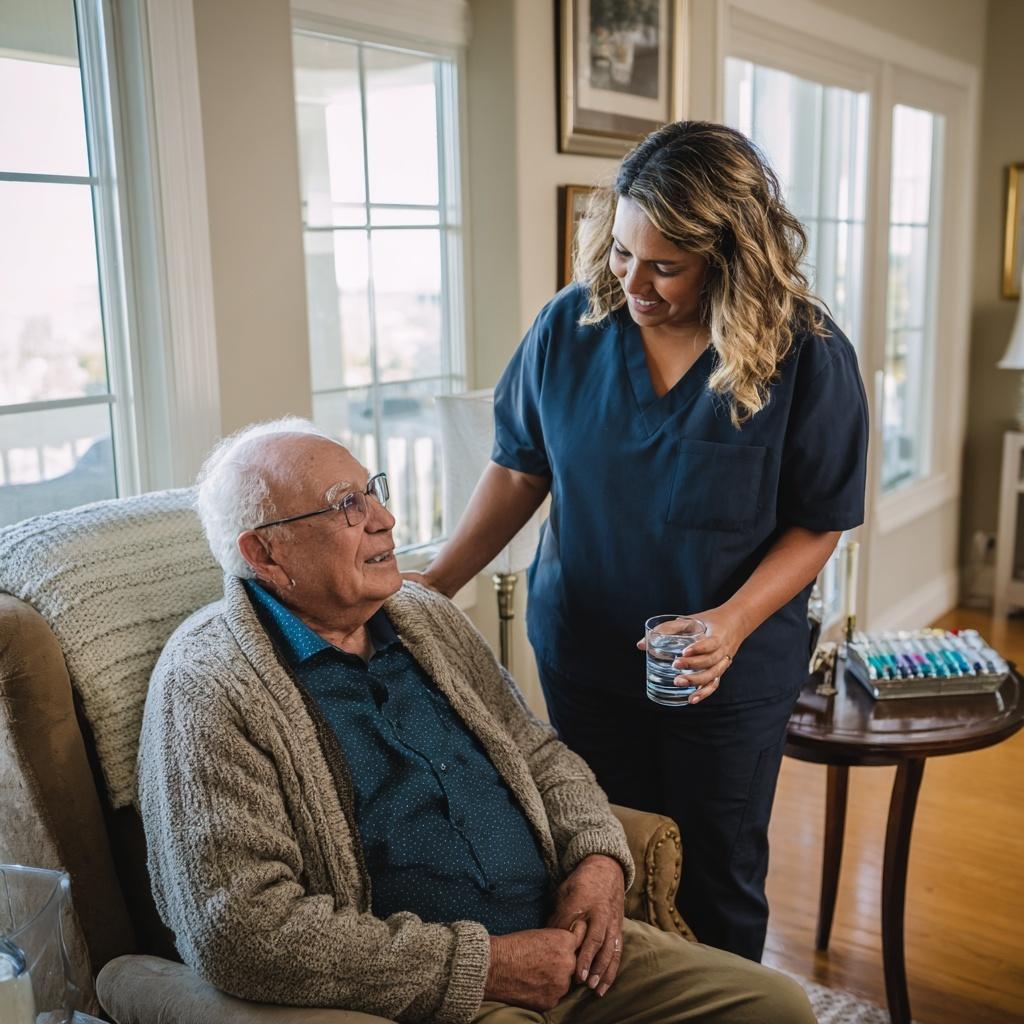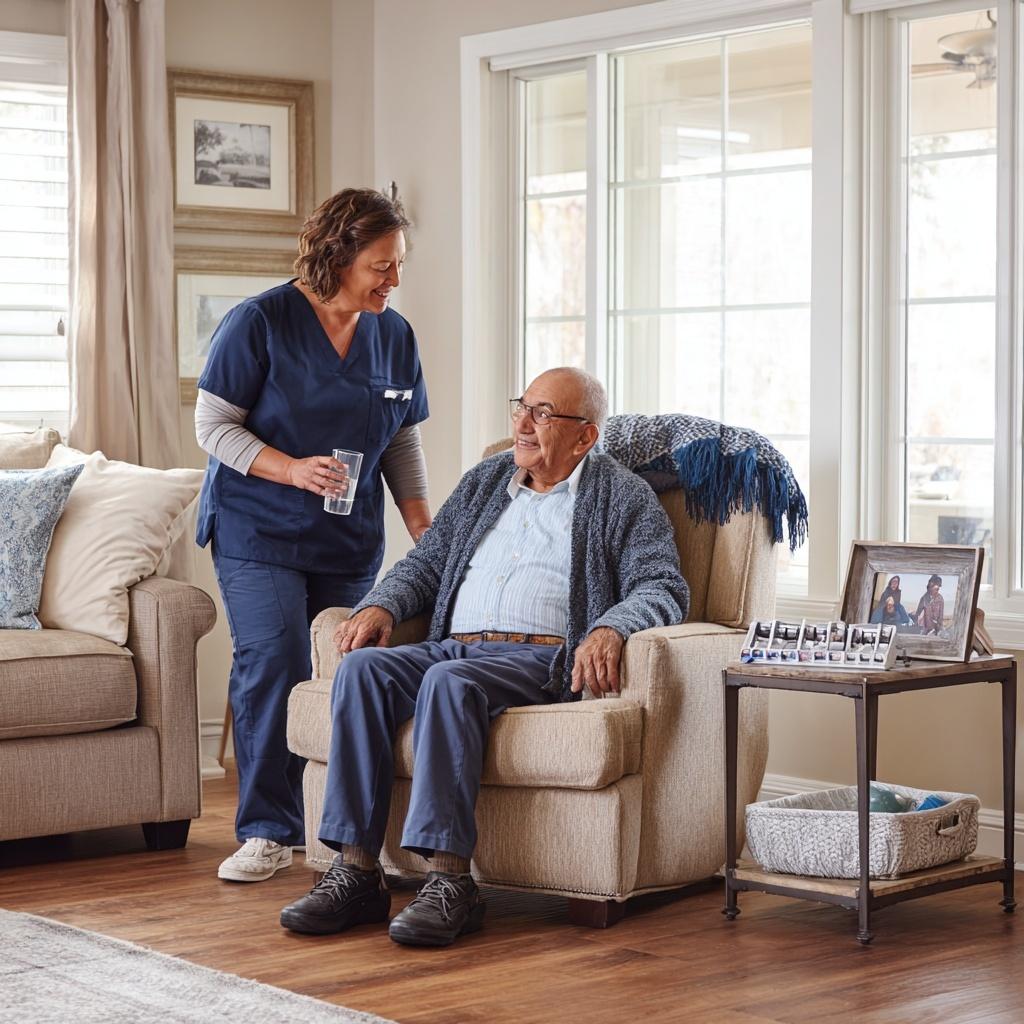
Aging at home sounds ideal, but when simple tasks become difficult, and safety is at risk, something has to change. Assisted living care doesn’t only happen in facilities. It can happen right where your loved one feels most secure, which is at home.
At Live Life At Home in Irvine, CA, we provide seniors with professional in-home assistance that meets their care needs without uprooting their lives. Our caregivers aren’t just there to help; they’re there to help seniors thrive. With a personalized touch and a focus on dignity, we make every day feel a little easier, a little brighter, and a lot more secure.
Here’s how our assisted living services at home help your loved ones keep living life on their terms.
1. Personalized Daily Living Assistance at Home
Daily tasks that once felt automatic (getting dressed, brushing teeth, making breakfast) can become challenging with age. These are known as activities of daily living (ADLs), and when seniors start struggling with them, it’s a clear sign they need more support. But that doesn’t mean moving into a facility is the only option.
How We Tailor Care to Every Senior
The first step is always listening. We begin with a free care evaluation, where one of our client care consultants visits the home, speaks with the family, and assesses the specific level of care needed. From mobility issues to memory lapses, we take the time to understand every detail. The result is a personalized care plan that adapts to the individual, not the other way around.
Whether it’s helping with bathing, grooming, or incontinence care, our trained caregivers provide personal care services that support both physical health and emotional well-being. Each caregiver is matched with the senior based on personality, preferences, and care requirements to build comfort and trust from day one.
Maintaining Routine, Dignity, and Independence
What many don’t realize is that helping with small tasks can have a big impact. Seniors who get help with personal care are more likely to stay independent in other areas of life. They feel more confident leaving the house, seeing friends, or enjoying hobbies.
Even something as simple as a morning routine (washing up, getting dressed, having a hot meal) can completely change how someone feels about their day. Our care providers don’t just assist; they uplift.
Why Home-Based Support Beats the Facility Route for Many
Assisted living facilities and nursing homes certainly serve a purpose, but they’re not for everyone. For many seniors, the idea of leaving their homes and adjusting to a new environment is overwhelming and unnecessary. Home care fills that gap by providing the same level of professional care without the emotional toll of a move.
Here’s a comparison of typical care options:
| Type of Senior Living | Environment | Level of Care Offered | Ideal For |
| In-Home Assisted Living | Own home | Personal care, companionship | Seniors who want to age in place |
| Assisted Living Communities | Shared housing | ADLs, social activities | Seniors needing moderate care |
| Nursing Homes | Institutional | Skilled nursing care | Seniors with complex medical needs |
| Independent Living | Shared housing | Minimal support | Active seniors with few health concerns |
By choosing Live Life At Home, you give your loved one the gift of personalized care in the place they love most: their home.
2. Meal Preparation & Nutrition Support

Eating well is one of the most powerful ways to stay healthy with age, yet many seniors struggle to maintain proper nutrition.
Cooking with Care and Health in Mind
At Live Life At Home, we go far beyond frozen meals and food delivery. Our home care team prepares fresh, balanced meals in the senior’s kitchen, using their favorite ingredients while adapting recipes for dietary needs.
Whether your loved one is managing diabetes, heart disease, or other chronic conditions, we create meals that align with doctor recommendations and personal taste. From low-sodium to soft-textured dishes, our caregivers bring care and support right to the dinner table.
We also monitor hydration, meal timing, and appetite changes, ensuring that every bite supports energy, immunity, and mood.
Why Seniors Struggle With Nutrition (And Why It Matters)
Many seniors living alone experience loss of appetite, depression, or confusion about what and when to eat. Some skip meals unintentionally. Others rely on snacks or processed foods because cooking feels too difficult. Over time, poor nutrition can lead to fatigue, muscle loss, weakened immune function, and even hospital visits.
That’s why having a caregiver prepare meals daily (or even a few times a week) can make a huge difference. It ensures that nutrition isn’t left to chance.
We also provide companionship during meals, which often improves appetite and makes eating a more enjoyable experience. Food becomes a source of comfort again, not just a necessity.
Supporting Special Diets With Ease
Our caregivers are trained in preparing meals for common medical diets such as:
- Low-sodium
- Diabetic-friendly
- Renal diets
- Low-cholesterol
- Soft or pureed foods
We follow physician or dietitian guidelines closely so your loved one gets the right nutrients in the right way every day. For families worried about their loved one’s eating habits, this offers peace of mind, and for seniors, it’s a return to flavorful, satisfying meals made just for them.
3. Medication Management & Health Monitoring
Medications are a lifeline for many seniors, but they can also be a source of confusion, stress, and serious risk when taken incorrectly. Mixing up pills, skipping doses, or doubling up by accident can have dangerous consequences. Yet, this happens more often than most families realize.
Helping Seniors Stay on Track
Our caregivers provide timely medication reminders to ensure prescriptions are taken as directed. Whether it’s a single daily dose or multiple medications with complex timing, we help track everything so there’s no guessing, forgetting, or accidental mixing.
Although we don’t administer medication ourselves (unless overseen by a licensed nurse), we work closely with families, doctors, and pharmacies to keep medication routines safe and consistent.
We also monitor for side effects, new symptoms, or signs that something might be wrong. If a senior is unusually drowsy, dizzy, or unsteady, we notify the proper medical contacts right away.
Light Health Checks and Early Intervention
In addition to medication support, our caregivers perform basic health monitoring tasks such as:
- Noting appetite changes
- Checking for swelling or bruising
- Observing changes in energy or alertness
- Watching for mood shifts or confusion
These observations are shared with families or the senior’s health care provider so small problems don’t turn into major emergencies. Early intervention often prevents ER visits and improves overall healthcare outcomes.
Why It Matters for Long-Term Wellness
Seniors who manage their medications properly are more likely to avoid hospitalizations, stay independent longer, and enjoy a higher quality of life. For those with complex care plans or memory challenges, having a reliable system in place can make all the difference.
Medication mistakes don’t have to be part of aging. With our support, your loved one stays safe, stable, and on schedule without feeling micromanaged or overwhelmed.
4. Safe Mobility & Fall Prevention

One wrong step can change everything. A simple trip to the kitchen or bathroom could lead to a fall, a fracture, and weeks (or months) of recovery. For seniors, falls are not only painful but often life-altering. They’re the leading cause of injury-related deaths among older adults, yet most are preventable with the right help.
Physical Support That Keeps Seniors Moving Safely
At Live Life At Home, our caregivers assist with safe transfers in and out of beds, chairs, and vehicles. We understand that something as routine as standing up from a recliner can feel risky when balance or strength is compromised. Our goal is to provide just the right amount of support (never too much, never too little) so your loved one feels confident, not helpless.
Whether a senior uses a walker or cane or needs an arm to lean on, we’re there to reduce the risk of falls during everyday movements. And we don’t just help physically; we encourage movement, too.
Why Movement Is Essential (Even When It Feels Risky)
It’s natural to become more cautious with age, especially after a fall or near-miss. But avoiding movement can make the situation worse. Muscles weaken, joints stiffen, and independence fades. That’s why our caregivers gently encourage light physical activity tailored to ability, such as short walks, stretching routines, or seated exercises.
Even a few minutes a day can improve circulation, joint flexibility, and confidence. We focus on creating a safe assisted living setting at home, where movement is part of the daily routine, not something to fear.
Making the Home Safer Room by Room
Many homes weren’t built with aging in mind. Loose rugs, dim lighting, and cluttered hallways can pose hidden dangers. As part of our service, we help identify and address common household hazards:
- Install grab bars in bathrooms
- Remove or secure tripping hazards
- Add non-slip mats in the kitchen and shower
- Suggest layout changes to open walking paths
- Improve lighting in hallways and staircases
We’ll also collaborate with your senior living advisor, social worker, or medical professional if needed to recommend changes based on health or mobility levels.
For families worried about their loved one falling, this kind of proactive attention offers lasting peace of mind. And for seniors? It means moving around their home with confidence again.
5. Companionship & Social Enrichment
For many seniors, social interaction becomes increasingly rare. Friends may pass away, family members get busy, and leaving the house isn’t as easy as it used to be. The result is something far more serious, which could result in chronic loneliness, which has been linked to depression, memory decline, and even earlier death.
Real Connection That Makes a Difference
Our caregivers are trained to be companions. They engage with seniors through conversation, games, stories, hobbies, and shared meals. These daily moments of connection are just as valuable as medication reminders or help with bathing.
Whether it’s watching a favorite show together or talking about grandkids, companionship brings warmth and meaning to everyday life. And when trust builds, seniors feel safer asking for help, expressing concerns, or simply enjoying someone’s company again.
Activities That Engage the Mind and Heart
We believe that assisted living care should never be dull. That’s why we tailor activities to each person’s interests, mobility level, and cognitive ability. Some clients love puzzles or word games. Others enjoy reading aloud, scrapbooking, or light gardening.
When appropriate, we help seniors video call family, celebrate birthdays, or go out for short walks and fresh air. These activities are essential to maintaining cognitive function, emotional stability, and life satisfaction.
For seniors with early-stage memory concerns, these routines also provide helpful mental stimulation that may slow progression and support better brain health.
Companionship in a Senior Living Setting Without the Move
What makes our service unique is that we bring the benefits of senior living communities (social interaction, engagement, routine) right into the senior’s home. There’s no need to move into an assisted living facility to enjoy structure and companionship.
With the same caregiver visiting regularly, relationships grow naturally. Your loved one isn’t just receiving care and services; they’re building connection and trust with someone who genuinely cares. The result? A more meaningful day, a better night’s sleep, and a deeper sense of purpose.
6. Respite Care for Family Caregivers

Caring for a loved one is an act of love, but let’s be honest; it can also feel like a full-time job, especially when you’re juggling your own family, career, and life. That’s where respite care becomes not just helpful but essential.
Because Caregivers Need Care Too
Family caregivers often put their own health and needs last. You might skip your own doctor visits, feel constant guilt for not doing more, or go weeks without a real break. This isn’t sustainable, and it’s one of the leading causes of burnout. Live Life At Home offers flexible respite care options so you can step away without worry. You don’t have to do it all alone, and you shouldn’t have to.
Maintaining Routine and Continuity for the Senior
When caregivers rotate or change constantly, seniors may feel confused or anxious. That’s why we prioritize continuity of care. We take the time to learn your existing routines, care plans, and preferences so that your loved one barely notices the transition. Meals are prepared the same way. Medications stay on schedule. Familiar faces return.
This seamless approach keeps things stable, which is especially important for seniors with memory care needs or early cognitive decline. They continue to receive dependable care, and you get time to rest without sacrificing their comfort.
When to Consider Respite Care
You don’t need to hit a breaking point to justify a break. Consider scheduling respite care if:
- You’re starting to feel emotionally or physically drained
- You’re recovering from illness or surgery yourself
- You have an upcoming work deadline, event, or vacation
- You want to prevent caregiver burnout before it begins
Our assisted living care at home adapts to your schedule and your needs. Some families book regular weekly breaks. Others call us when something unexpected comes up. Either way, our team is reliable, experienced, and ready to help.
7. Household Management & Home Environment Care
A cluttered home can be dangerous. Laundry piles, loose cords, and dusty floors aren’t just signs of neglect. They’re trip hazards, breathing irritants, and constant reminders that life is getting harder to manage alone. But here’s the good news: your loved one doesn’t have to manage it alone.
Light Housekeeping With a Big Impact
Our caregivers help keep the home environment clean, organized, and comfortable. That includes light chores such as:
- Doing the laundry
- Washing dishes
- Sweeping and vacuuming
- Taking out the trash
- Tidying up living areas
These tasks may seem minor, but for seniors, they often become exhausting or physically risky. By taking these off their plate, we free up energy for what matters most. We don’t replace professional cleaners, but we ensure the day-to-day upkeep doesn’t spiral into overwhelm.
Home Safety Checks to Prevent Accidents
One of the most overlooked forms of support is simply checking for hazards. Our team is trained to spot risks most families might miss. We look out for:
- Poor lighting in hallways and stairs
- Loose rugs or cords in walking paths
- Clutter in entryways
- Unstable furniture
- Hot water temperatures that are too high
Small changes like rearranging furniture or adding a nightlight can significantly reduce fall risk. If more complex safety modifications are needed (like grab bar installations or non-slip flooring), we’ll recommend them and help coordinate with professionals if needed. This is part of what sets us apart.
A Safe and Respectful Living Environment
Beyond the physical space, our caregivers are trained in elder care ethics and abuse prevention. Seniors (especially those dealing with cognitive decline) are vulnerable to neglect or mistreatment in some long-term care facilities. By keeping care at home and assigning consistent caregivers, we reduce those risks dramatically. The home remains a place of dignity, familiarity, and peace.
This all ties into our philosophy of assisted living: support seniors where they are and make every day easier, safer, and more comfortable.
8. Holistic Wellness: Nutrition, Mobility, Mental Health

Providing support with daily activities is just one part of the equation. At Live Life At Home, we also focus on the bigger picture: how everything works together to support your loved one’s overall well-being. That includes how they move, what they eat, how they feel, and how connected they are to others.
Why a Whole-Person Approach Matters
A senior who eats well but never moves may still suffer from stiffness, weakness, or depression. Someone who takes all their medication but sits alone all day can still fall into cognitive decline. That’s why we take a whole-person approach.
We tie together key elements of senior wellness:
- Nutrition support to fuel the body
- Mobility encouragement to keep joints and muscles active
- Social connection to boost emotional resilience
- Mental stimulation to support memory and focus
When these elements work together, seniors thrive physically, emotionally, and mentally.
Supporting the Mind and Mood
Many seniors experience sadness due to isolation or physical decline. That’s why our caregivers ensure to engage with the seniors. They ask questions, listen to stories, initiate activities, and offer consistent, friendly conversation.
We also gently integrate memory support through routines, labeling items, and encouraging independence. For those in the early stages of memory loss, this helps them remain engaged and oriented longer.
We may not provide licensed counseling, but we know the power of empathy, routine, and trust. And often, that’s exactly what’s needed.
9. Family Collaboration & Communication
Your loved one’s care shouldn’t be a mystery. And you shouldn’t feel out of the loop, especially when it’s happening in their own home. That’s why we prioritize clear, ongoing communication with families from the start.
You’re Always in the Know
We provide regular updates through caregiver notes, calls, and check-ins. If anything seems different (whether it’s a change in appetite, behavior, or sleep), we let you know immediately. If there’s something to celebrate, like a big win in physical mobility or renewed energy, we share that, too.
Our care plans are living documents, not one-time checklists. As your loved one’s needs evolve, we adjust together. This transparency helps build trust and keeps everyone working toward the same goal: helping your loved one live well at home.
Frequently Asked Questions
1. What is the meaning of an assisted living system?
An assisted living system is a residential setup that provides personal care and support services to seniors who need help with daily activities. This includes help with bathing, dressing, medication management, meals, and housekeeping while still promoting independence in a home-like environment.
2. Which is more expensive, home care or assisted living?
Home care is generally more expensive than assisted living. This is because home care involves one-on-one services provided in a private residence, which can quickly add up, especially for 24/7 care. Assisted living offers shared staffing and resources, making it more cost-effective for individuals needing daily support.
3. How long do most people live in assisted living?
Most people live in assisted living for about 22 months. The average stay is just under two years, after which many residents transition to a higher level of care, such as a nursing home, or pass away, depending on their health condition.
4. What are the 5 levels of care in assisted living?
The 5 levels of care in assisted living are: Level 1 (Low), Level 2 (Moderate), Level 3 (High), Level 4 (Advanced), and Level 5 (Comprehensive).
These levels indicate the degree of support a resident needs with daily living activities:
- Level 1 – Low Care: Minimal assistance is needed; residents are mostly independent and may only need help with reminders or light tasks.
- Level 2 – Moderate Care: Some help is required with daily tasks like bathing, dressing, or medication management.
- Level 3 – High Care: More frequent hands-on assistance with most activities of daily living (ADLs).
- Level 4 – Advanced Care: Intensive support is needed; residents may have limited mobility or cognitive decline.
- Level 5 – Comprehensive Care: Highest level of non-nursing home care; includes near-total assistance, often with complex physical or cognitive needs.
Each community may label or define these levels slightly differently, but they follow a similar progression based on resident needs.
Conclusion: Helping Seniors Thrive One Day at a Time
Aging doesn’t mean giving up control, joy, or independence. At Live Life At Home, we believe the right support (offered with respect, warmth, and consistency) can help seniors flourish, even as their needs grow.
From personal care and meal support to fall prevention, companionship, and family communication, we cover all the essentials of assisted living care without requiring your loved one to leave their home.
If you’re looking for assisted living services in Irvine, CA, that prioritize both safety and dignity, let’s talk. We’re ready to help you explore your care options, answer your questions, and give your loved one the kind of support that truly helps them thrive. Schedule a consultation today!
